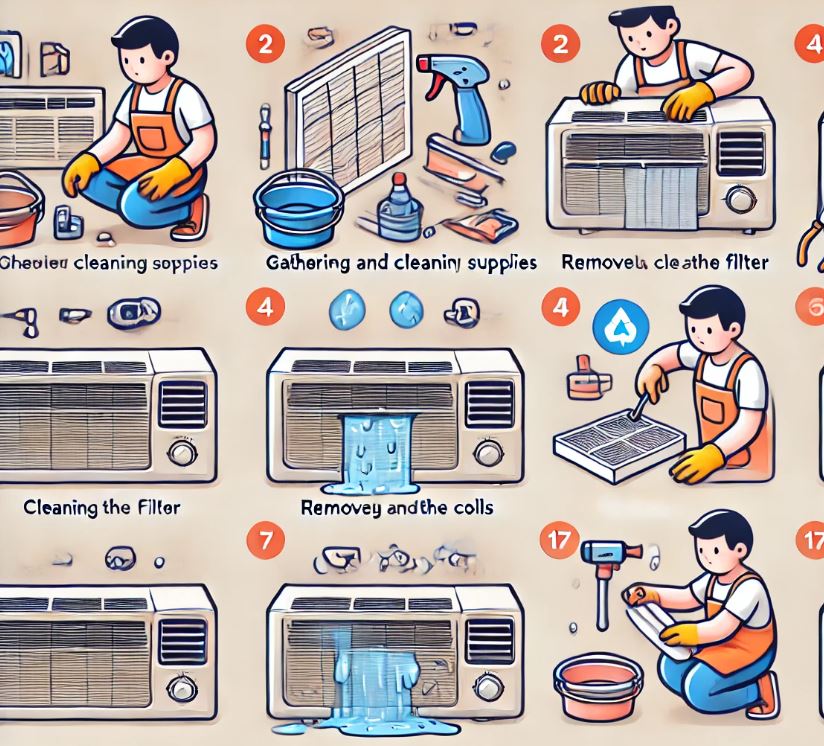I'm a participant in the Amazon Services LLC Associates Program, an affiliate advertising program designed to provide a means for me to earn fees by linking to Amazon.com and affiliated sites.
Cleaning your window air conditioner regularly is essential for maintaining its efficiency and prolonging its lifespan. This guide provides a comprehensive step-by-step process of how to clean a window air conditioner effectively, ensuring you enjoy cool, clean air throughout the year.
Looking for a larger AC? Our guide on the Best Window AC for Large Rooms might be exactly what you need.
Key Takeaways
- Regular cleaning of your window air conditioner ensures efficient performance and longevity.
- Follow a detailed step-by-step process to clean the filter, coils, and other components.
- Proper maintenance can prevent costly repairs and improve air quality.
Why Cleaning Your Window Air Conditioner Is Important
Maintaining Efficiency
A clean air conditioner runs more efficiently, saving energy and reducing electricity bills. Dust and debris can obstruct airflow, forcing the unit to work harder and consume more power.
Improving Air Quality
Regular cleaning prevents the buildup of mold, mildew, and bacteria, which can negatively affect indoor air quality. This is particularly important for those with allergies or respiratory conditions.
Extending Lifespan
Routine maintenance helps to avoid wear and tear, extending the lifespan of your air conditioner. This can prevent costly repairs or the need for premature replacement.
Step-by-Step Guide to Cleaning Your Window Air Conditioner
1. Gather Your Cleaning Supplies
Before you start, ensure you have the following supplies:
- Screwdriver
- Vacuum cleaner with a brush attachment
- Soft cloth or sponge
- Mild detergent
- Fin comb (optional)
- Bucket of warm water
2. Turn Off and Unplug the Unit
Safety first! Ensure the air conditioner is turned off and unplugged before beginning any cleaning procedures.
3. Remove and Clean the Filter
The filter is one of the most critical components to clean regularly.
- Open the front cover of the unit.
- Remove the filter.
- Vacuum the filter to remove loose dust and debris.
- Wash the filter with warm water and mild detergent.
- Rinse thoroughly and let it dry completely before reinstalling.
4. Clean the Coils
Dirty coils can reduce the efficiency of your air conditioner.
- Remove the outer casing to access the coils.
- Use a vacuum cleaner with a brush attachment to gently remove dust and debris from the coils.
- If the coils are heavily soiled, use a soft cloth or sponge with a mild detergent solution to clean them.
- Rinse with water and allow to dry completely.
5. Clean the Drain Pan and Drain
A blocked drain can cause water to accumulate and potentially damage the unit.
- Locate the drain pan and clean it with a mild detergent solution.
- Ensure the drain is clear by running a wire or a small brush through it.
6. Reassemble the Unit
Once all components are clean and dry, reassemble the unit. Ensure all screws and covers are securely fastened.
7. Test the Air Conditioner
Plug in the unit and turn it on to ensure it is operating correctly. Check for any unusual noises or vibrations.
Recent Developments in the Field
Innovations in Self-Cleaning Technology
Recent advancements in air conditioner technology include self-cleaning features that reduce the need for manual maintenance. These units use special coatings and automated cycles to keep the interior components clean, enhancing efficiency and longevity.
Improved Filtration Systems
Modern air conditioners now come with advanced filtration systems that capture more particles, including allergens and pollutants. This development significantly improves indoor air quality, making it beneficial for those with health concerns.
Eco-Friendly Refrigerants
The industry is shifting towards eco-friendly refrigerants with lower global warming potential (GWP). These new refrigerants help reduce the environmental impact of air conditioning systems.
Top Experts and Entities in the Field – How to Clean a Window Air Conditioner
American Society of Heating, Refrigerating and Air-Conditioning Engineers (ASHRAE)
ASHRAE is a leading organization providing extensive research and guidelines on HVAC systems, including air conditioners.
Carrier Corporation
Carrier is renowned for its innovative and energy-efficient air conditioning solutions.
U.S. Environmental Protection Agency (EPA)
The EPA offers valuable resources and regulations to ensure air conditioning systems are environmentally friendly and energy-efficient.
Other Interesting Articles
Enhance your understanding and explore more cooling solutions with our detailed reviews and comparisons:
- Discover the Best Desk Fan for a refreshing breeze at your workspace.
- Learn about the Best Window AC Unit 6000 BTU for smaller rooms.
- Compare the features of Midea vs LG ThinQ to find the best smart air conditioner.
- Understand the differences between Midea vs LG Dual Inverter for advanced cooling technology.
- Check out our comparison of Midea vs Frigidaire to choose the right model for your home.
Author
HappyHomeNerd is an expert in home appliances and HVAC systems with many years of experience in the field. Their insights and reviews help consumers make informed decisions for a comfortable and energy-efficient home.
By following this guide, you can keep your window air conditioner clean and efficient, ensuring optimal performance and a longer lifespan. Regular maintenance not only enhances your comfort but also contributes to better air quality and energy savings.
